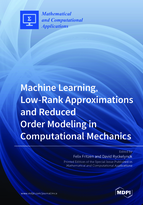Machine Learning, Low-Rank Approximations and Reduced Order Modeling in Computational Mechanics
A special issue of Mathematical and Computational Applications (ISSN 2297-8747). This special issue belongs to the section "Engineering".
Deadline for manuscript submissions: closed (31 March 2019) | Viewed by 37964
Special Issue Editors
Interests: solid mechanics; material modeling; model reduction and computer-aided simulation
Interests: computational methods in structural mechanics (model reduction of non-linear systems, hyper-reduction, incremental proper orthogonal decomposition, contact and parallel computations); multiphysic modeling of thermomechanical processes; inverse problems
Special Issue Information
Dear Colleagues,
The solution of engineering problems using simulation tools has reached a mature state over the past few decades. With the ever-increasing features included into the simulations, the technical challenges for simulations have increased. This is particularly true as simulations are also used to explore high-dimensional parameter spaces, to optimize designs, provide means for optimal control problems and—more recently—they are carried out on low-cost devices. The replacement of dedicated simulations by data-driven methods, by low-rank approximations and by reduced modeling strategies is an active field of research that is quickly finding its way into industrial applications for obvious reasons. Articles related to the development and the properties of methods from the fields of machine learning, tensor and low-rank approximations and reduced order modeling are welcome in this special issue. Papers connecting the different disciplines and regarding error control for surrogate models are particularly welcome. Authors are invited to upload supplementary material, e.g., software, data-sets or instructive videos complementing the research.
Prof. Dr. Felix Fritzen
Prof. Dr. David Ryckelynck
Guest Editors
Manuscript Submission Information
Manuscripts should be submitted online at www.mdpi.com by registering and logging in to this website. Once you are registered, click here to go to the submission form. Manuscripts can be submitted until the deadline. All submissions that pass pre-check are peer-reviewed. Accepted papers will be published continuously in the journal (as soon as accepted) and will be listed together on the special issue website. Research articles, review articles as well as short communications are invited. For planned papers, a title and short abstract (about 100 words) can be sent to the Editorial Office for announcement on this website.
Submitted manuscripts should not have been published previously, nor be under consideration for publication elsewhere (except conference proceedings papers). All manuscripts are thoroughly refereed through a single-blind peer-review process. A guide for authors and other relevant information for submission of manuscripts is available on the Instructions for Authors page. Mathematical and Computational Applications is an international peer-reviewed open access semimonthly journal published by MDPI.
Please visit the Instructions for Authors page before submitting a manuscript. The Article Processing Charge (APC) for publication in this open access journal is 1400 CHF (Swiss Francs). Submitted papers should be well formatted and use good English. Authors may use MDPI's English editing service prior to publication or during author revisions.







